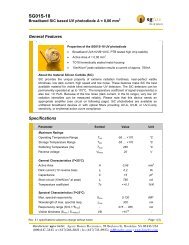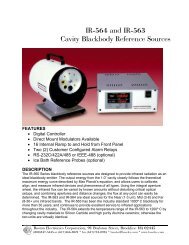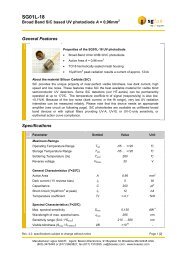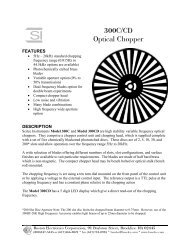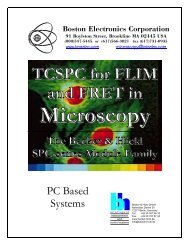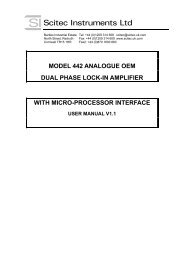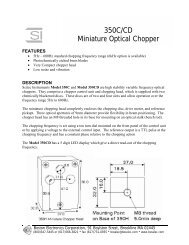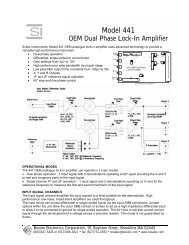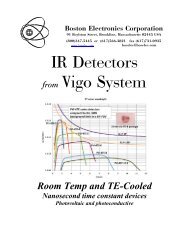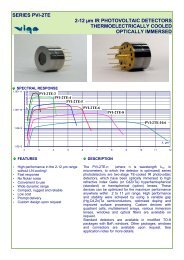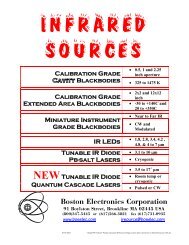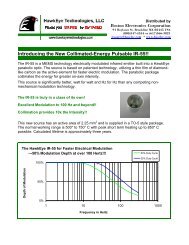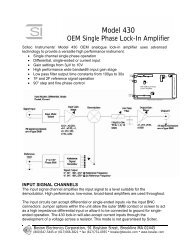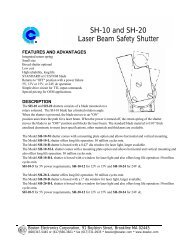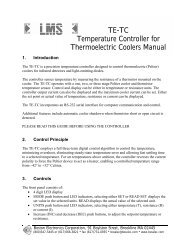SiC UV Photodiode Selection Guide - Boston Electronics Corporation
SiC UV Photodiode Selection Guide - Boston Electronics Corporation
SiC UV Photodiode Selection Guide - Boston Electronics Corporation
Create successful ePaper yourself
Turn your PDF publications into a flip-book with our unique Google optimized e-Paper software.
S<br />
<strong>SiC</strong> <strong>UV</strong> <strong>Photodiode</strong> <strong>Selection</strong> <strong>Guide</strong><br />
Basic Information<br />
•<br />
<strong>SiC</strong> <strong>UV</strong> <strong>Photodiode</strong> <strong>Selection</strong> <strong>Guide</strong><br />
That guide assists you selecting the right <strong>UV</strong> Silicon Carbide (<strong>SiC</strong>) based<br />
photodiode for your application. Basically this selection is between active<br />
area, spectral behaviour, packaging and additional special features. This<br />
first page is basic information and subsequent pages provide background<br />
knowledge and electronic circuit examples.<br />
About the sglux Silicon Carbide (<strong>SiC</strong>) <strong>UV</strong> photodiodes<br />
The offered <strong>UV</strong> photodiodes base on a Silicon Carbide detector chip. <strong>SiC</strong> provides the unique<br />
property of near-perfect visible blindness, low dark current, high speed and low noise. These<br />
features make <strong>SiC</strong> the best available material for visible blind semiconductor <strong>UV</strong> detectors.<br />
The <strong>SiC</strong> detectors can be continuously operated at up to 120°C. All photodiodes are available<br />
with HT (high temperature) feature that allows operation up to 170°C (338°F). The<br />
temperature coefficient of signal is
S<br />
<strong>SiC</strong> <strong>UV</strong> <strong>Photodiode</strong> <strong>Selection</strong> <strong>Guide</strong><br />
Background Information<br />
•<br />
Table of Contents<br />
1.0 <strong>Selection</strong> of the Chip active area (photocurrent limits)<br />
1.1 Problems with current too low (circuit linearity & temperature issues)<br />
1.2 Problems with current too high (saturation)<br />
1.3 Calculation of the relation between <strong>UV</strong> radiation and photocurrent<br />
2.0 <strong>Selection</strong> of the Spectral Response<br />
2.1 Unfiltered <strong>SiC</strong><br />
2.2 Filtered <strong>SiC</strong><br />
3.0 Packaging features<br />
3.1 Overview<br />
3.2 Drawings<br />
4.0 Special features<br />
Appendix A <strong>Photodiode</strong> Amplification Notes<br />
Appendix B Accessoires<br />
page 2<br />
page 3<br />
page 5<br />
page 5<br />
page 7<br />
page 7<br />
page 8<br />
page 9<br />
page 9<br />
page 10<br />
page 12<br />
page 13<br />
page 13<br />
Appendix C <strong>Photodiode</strong> Calibration Service page 13<br />
1.0 <strong>Selection</strong> of the Chip active area (photocurrent limits)<br />
The chip active area determines how many light quantum, (photons), can be collected by a<br />
photodetector. Semiconductor detectors, such as <strong>SiC</strong> <strong>UV</strong> photodiodes, convert the photons<br />
into an electrical current, the photocurrent I. This photocurrent rises linearly with the chip<br />
active area. sglux currently offers four different area sizes<br />
A1 = 0.04 mm 2 (S-type)<br />
A2 = 0.20 mm 2 (M-type)<br />
A3 = 1.00 mm 2 (L-type)<br />
A4 = 4.00 mm 2 (XL-type)<br />
As the detector price rises with increasing active area, (see price information at p.1), the area<br />
selection basically is a compromise between costs and current.<br />
If you know the minimum and maximum irradiance you like to measure with the <strong>UV</strong><br />
photodiode the following simplified formula (1) shows a rough estimation of the photocurrent I<br />
given a particular chip active area AChip.<br />
I = Achip ∗ Eλ ∗ 1.000 (1)<br />
Rev. 4.0 specifications subject to change without notice Page 2 [13]<br />
Manufacturer: sglux GmbH; Agent: <strong>Boston</strong> <strong>Electronics</strong>, 91 Boylston St, Brookline MA 02445 USA<br />
(800) 3475445 or (617) 5663821; fax (617) 7310935; uv@boselec.com ; www.boselec.com<br />
A
S<br />
<strong>SiC</strong> <strong>UV</strong> <strong>Photodiode</strong> <strong>Selection</strong> <strong>Guide</strong><br />
I is the photocurrent in nA, Achip is the chip active area in mm 2 (enter values of 0.04 or 0.20 or<br />
1 or 4) and Eλ is the spectral irradiance of the <strong>UV</strong> light source you like to measure in mWcm -<br />
2 nm -1 . You may find more information about photocurrent calculation in chapter 1.3<br />
(Calculation of the relation between <strong>UV</strong> radiation and photocurrent), p. 5.<br />
If you do not know the irradiance coming from your <strong>UV</strong> light source chapter 1. section 1.3<br />
gives some examples of common <strong>UV</strong> sources.<br />
The minimum current (photodiode output at lowest irradiance to be measured) should not fall<br />
below 500pA. The maximum current should not exceed 2µA and must not exceed 40µA if the<br />
component’s diode properties are to be maintained. Please refer to a detailed discussion on<br />
suitable minimum and maximum currents in the following chapters 1. section 1.1 (Problems<br />
with current too low) and 1. section 1.2 (Problems with current too high). These chapters<br />
assume a certain basic knowledge in photodiode amplifier circuits. If you are not familiar with<br />
circuits please see Appendix A (<strong>Photodiode</strong> Amplification Notes) at page 10.<br />
1.1 Problems current with too low<br />
If the current is too low, one ore more of the following problems (P1 – P4) may affect the<br />
measurement:<br />
P1 The measurement signal comes too close to the <strong>UV</strong> photodiode dark current<br />
P2 High resistance feedback resistors (Rf) must be used which causes<br />
temperature drift and non linearity problems<br />
P3 Speed problems<br />
P4 Risk of electromagnetic interferences<br />
Using <strong>SiC</strong>, P1 can be neglected due to the extremely low dark current of the sglux 4H <strong>SiC</strong> <strong>UV</strong><br />
photodiodes of only some fA. P2 (temperature drift and non linearity) becomes essential<br />
from values Rf > 10 GΩ. Therefore, the photocurrent I should be strong enough to allow Rf<br />
values of ≤ 10 GΩ. The relation between I and Rf is given by Ohm’s law:<br />
I = Usupply / Rf (2)<br />
where Usupply is the supply voltage of the used transimpedance amplifier. A typical value is<br />
5.00 V. Formula (2) calculates:<br />
Imin = 5.00V/10 GΩ = 500pA (3)<br />
Rev. 4.0 specifications subject to change without notice Page 3 [13]<br />
Manufacturer: sglux GmbH; Agent: <strong>Boston</strong> <strong>Electronics</strong>, 91 Boylston St, Brookline MA 02445 USA<br />
(800) 3475445 or (617) 5663821; fax (617) 7310935; uv@boselec.com ; www.boselec.com
S<br />
<strong>SiC</strong> <strong>UV</strong> <strong>Photodiode</strong> <strong>Selection</strong> <strong>Guide</strong><br />
•<br />
If a higher speed measurement is needed P3 (speed problems) could become an issue. As<br />
the <strong>SiC</strong> <strong>UV</strong> photodiode’s detection speed is extremely high (in nanoseconds only) the<br />
amplifier speed (rise time) always determines the circuit’s speed. The amplifier rise time is<br />
calculated with the following formula:<br />
τ = Rf ∗ Cf (4)<br />
where Cf is the feedback capacitor value which should not be lower than 0.1 nF. A lower Cf<br />
risks hitting the circuit’s resonance. Using a Cf = 0.1 nF and a Rf = 10 GΩ the rise time is<br />
calculated as follows:<br />
τ = 10 GΩ ∗ 0.1 nF = 1 second (5)<br />
Formula (5) shows that using a Rf = 10 GΩ the circuit becomes very slow. If a higher speed is<br />
needed the photocurrent I must be increased to allow a decrease in the Rf value. This can be<br />
done by increasing the <strong>UV</strong> radiation or, if that is not feasible, by increasing the chip active<br />
area.<br />
The last problem (P4) that can be caused with too low photocurrent (= due to too small an<br />
active area) is complications from electromagnetic interferences. This is a general issue.<br />
Decreasing photocurrents call for increasing shielding efforts which then increases the system<br />
price of the product. If the radiation (and thus the current) is low one should consider using a<br />
sglux TOCON pre-amplified hybrid <strong>UV</strong> sensor.<br />
Conclusion of needed minimum photocurrent Imin<br />
To achieve a stable temperature and linear photodiode-amplifier system the lowest<br />
measurement current Imin should be higher than 500pA. If a high speed measuring circuit is<br />
needed Imin is calculated by the following formula:<br />
Imin = Usupply ∗ Cf ∗ τ −1 (6)<br />
With Usupply = 5.00V (typical value), Cf = 0.1nF (recommended value) and Rf = 10 GΩ (lowest<br />
recommended value) the formula reduces to:<br />
Imin = 500 ∗ τ −1 (7)<br />
where Imin results in nanoamperes (nA) and τ must be in milliseconds.<br />
In general, given these reasons, a decreasing photocurrent needs a more advanced amplifier<br />
design and better shielding. If you are not familiar with low current circuit development you<br />
should consider selecting a higher current (and thus larger active area) photodiode even if the<br />
price of a photodiode is higher. This strategy will provide conservative results and the initial<br />
increased financial cost will save you money in the long run.<br />
Rev. 4.0 specifications subject to change without notice Page 4 [13]<br />
Manufacturer: sglux GmbH; Agent: <strong>Boston</strong> <strong>Electronics</strong>, 91 Boylston St, Brookline MA 02445 USA<br />
(800) 3475445 or (617) 5663821; fax (617) 7310935; uv@boselec.com ; www.boselec.com<br />
A
S<br />
<strong>SiC</strong> <strong>UV</strong> <strong>Photodiode</strong> <strong>Selection</strong> <strong>Guide</strong><br />
•<br />
1.2 Problems with current too high (saturation)<br />
In the previous pages we discussed the calculation of a minimum recommended photodiode<br />
current. It also should be mentioned that aside from the photocurrent being too low too high of<br />
a current may cause problems as well due to saturation effects. The saturation current Isat of a<br />
photodiode is the current limit from which the output of a photodiode turns to arbitrary values.<br />
It is determined by the photodiode’s open circuit voltage VOC and its serial resistance RS<br />
following the formula below:<br />
Isat = VOC / RS (8)<br />
A typical value (<strong>SiC</strong> photodiode) for VOC is 2.0V and for RS = 50kΩ. The calculation is a<br />
follows:<br />
Isat = 2.0 V / (50 ∗ 10 3 ) Ω = 4 ∗ 10 -5 A = 40µA.<br />
The needed minimum current (500 pA) is higher than the saturation current is higher by six<br />
orders of magnitude. Reaching the saturation limit of a <strong>SiC</strong> photodiode is therefore very<br />
unlikely.<br />
However, one should consider that a <strong>SiC</strong> <strong>UV</strong> photodiode is a sensible instrument for<br />
measurement. Even if <strong>SiC</strong> <strong>UV</strong> photodiodes are the most stable and most linear <strong>UV</strong><br />
photodiodes currently available, values that come close to the limit should be avoided. The<br />
majority of applications use a photocurrent range from 1nA to 2000nA. Thus, whenever<br />
possible, the maximum current should not exceed 2000nA.<br />
1.3 Calculation of the relation between <strong>UV</strong> radiation and photocurrent<br />
The photocurrent I is calculated by the following formula:<br />
I =<br />
where I is the photocurrent in A, Achip is the chip active area in m 2. Schip is the chip’s spectral<br />
sensitivity in AW -1 and Eλ is the spectral irradiance of the <strong>UV</strong> light source in Wm -2 nm -1 . Due to<br />
extreme visible and IR blindness the integral value from 400nm to ∞ can be neglected even if<br />
Esource(λ) is very strong. To get a rough estimate of the photocurrent generated by a certain<br />
irradiance a simplification of (9) leads to (10). That simplification assumes that the chip’s<br />
spectral sensitivity S and the <strong>UV</strong> source’s irradiance E is a constant value and does not<br />
depend on wavelength. The calculation is:<br />
I = Achip ∗ Schip ∗ Eλ ∗ 10.000 (10)<br />
where I is the photocurrent in nA, Achip is the chip active area in mm 2. Schip is the chip’s spectral<br />
sensitivity in AW -1 nm -1 and Eλ is the spectral irradiance of the <strong>UV</strong> light source in mWcm -2 nm -1 .<br />
Rev. 4.0 specifications subject to change without notice Page 5 [13]<br />
Manufacturer: sglux GmbH; Agent: <strong>Boston</strong> <strong>Electronics</strong>, 91 Boylston St, Brookline MA 02445 USA<br />
(800) 3475445 or (617) 5663821; fax (617) 7310935; uv@boselec.com ; www.boselec.com<br />
(9)<br />
A
S<br />
<strong>SiC</strong> <strong>UV</strong> <strong>Photodiode</strong> <strong>Selection</strong> <strong>Guide</strong><br />
A typical value of Schip is 0.1 A/W. For further refinement please refer to the spectral response<br />
graph of the <strong>UV</strong> photodiode you are interested in (see Datasheet) or have a look at chapter<br />
2.0 (<strong>Selection</strong> of the Spectral Response, p. 7) of this guide.<br />
If you know the theoretical spectral irradiance range, (minimal and maximal values), of the <strong>UV</strong><br />
light source and you would like to measure you can easily estimate the photocurrent I by<br />
using formula (10) and hence select a chip active area (S-, M-, L- or XL-type) that guarantees<br />
that your minimum radiation generates a photocurrent of more than 500 pA and your<br />
maximum radiation generates a current of, if possible, less than 2000 nA.<br />
The following table lists some common <strong>UV</strong> applications / light sources with their spectral<br />
irradiances at peak. Please note that some simplifications apply; thus the table gives a rough<br />
estimation of photocurrents for the different <strong>UV</strong> source types and different chip active areas.<br />
<strong>UV</strong> source Typ. peak Eλ<br />
lacquer hardening<br />
Fe doped Hg medium<br />
pressure lamp<br />
<strong>UV</strong> sterilisation<br />
low or medium pressure Hg<br />
lamp<br />
Industrial and R&D<br />
various sources<br />
<strong>UV</strong>-Index<br />
Sun<br />
Burner flame<br />
detection<br />
gas or oil flame<br />
Comments:<br />
lacquer hardening<br />
S-Type I M-Type I L-Type I XL-Type I<br />
10 W/cm 2 400 µA<br />
400 nA<br />
with<br />
attenuated<br />
„GIGA“<br />
feature<br />
2 mA 10 mA 40 mA<br />
10 mW/cm 2 400 nA 2 µA 10 µA 40 µA<br />
10 µW/cm 2<br />
- 1 mW/cm 2<br />
0.4 - 40 nA 2 – 200 nA 10 – 1000 nA 40 – 4000 nA<br />
10 µW/cm 2 400 pA 2 nA 10 nA 40 nA<br />
10 nW/cm 2 400 fA 2 pA<br />
100 pA with<br />
“LENS” feature<br />
10 pA 40 pA<br />
all current values of the standard photodiodes are too high. For lacquer hardening lamp<br />
control a special „GIGA“ attenuated photodiode will be applied. Please refer to chapter 4.0.<br />
(Special features) for more information.<br />
<strong>UV</strong> sterilisation<br />
S-chip is best. M, L, XL chips would work but are not needed.<br />
Industrial and R&D<br />
All chips are suited. Speed is the main consideration when selecting a chip being mindful of<br />
linearity and temperature dependence values. Please contact us for further refinement.<br />
Rev. 4.0 specifications subject to change without notice Page 6 [13]<br />
Manufacturer: sglux GmbH; Agent: <strong>Boston</strong> <strong>Electronics</strong>, 91 Boylston St, Brookline MA 02445 USA<br />
(800) 3475445 or (617) 5663821; fax (617) 7310935; uv@boselec.com ; www.boselec.com
S<br />
<strong>SiC</strong> <strong>UV</strong> <strong>Photodiode</strong> <strong>Selection</strong> <strong>Guide</strong><br />
•<br />
<strong>UV</strong>-Index<br />
S-Chips are too small for this application. All other chips can be applied. The reliability<br />
increases with increasing chip active area. Due to very low current the use of a TOCON (preamplified<br />
hybrid sensor) should be considered.<br />
Burner flame detection<br />
All chips are too small for this type of detection. A burner flame can be detected with the<br />
photodiode „SG10M-5Lens“. This sensor works with a concentrating lens. Please refer to<br />
chapter 4.0. (Special features), for more information. Another approach is to use a sglux<br />
TOCON_nano sensor with iits ncluded pre-amplifier. The TOCON_nano converts<br />
0-10 nW/cm 2 radiation into a 0-5 V output voltage.<br />
2.0 <strong>Selection</strong> of the Spectral Response<br />
This chapter assists in the selection of a spectral response profile best suited for the<br />
measurement. All sglux 4H <strong>SiC</strong> <strong>UV</strong> photodiodes provide an extreme visible/IR blindness of<br />
more than ten orders of magnitude. That means that the <strong>UV</strong> photodiodes reliably only<br />
measure the <strong>UV</strong> part of a radiation spectrum (and not the visible and/or infrared part), even if<br />
visible light or infrared radiation is strongly present. This is a unique feature of the<br />
semiconductor material <strong>SiC</strong>. Currently no other material provides that extreme visible<br />
blindness.<br />
2.1 Unfiltered <strong>SiC</strong><br />
The following graph shows the spectral curve of an unfiltered 4H <strong>SiC</strong> <strong>UV</strong> photodiode.<br />
The curve’s maximum is at approximately 300nm. The response falls down to 10% of<br />
maximum at 215nm, (<strong>UV</strong>C edge) and 365nm, (<strong>UV</strong>A edge). Unfiltered <strong>SiC</strong> can be used for any<br />
<strong>UV</strong> measurements where the whole <strong>UV</strong> band needs to be measured or a quasi<br />
monochromatic <strong>UV</strong> source (such as low pressure lamps) is controlled.<br />
Rev. 4.0 specifications subject to change without notice Page 7 [13]<br />
Manufacturer: sglux GmbH; Agent: <strong>Boston</strong> <strong>Electronics</strong>, 91 Boylston St, Brookline MA 02445 USA<br />
(800) 3475445 or (617) 5663821; fax (617) 7310935; uv@boselec.com ; www.boselec.com
S<br />
<strong>SiC</strong> <strong>UV</strong> <strong>Photodiode</strong> <strong>Selection</strong> <strong>Guide</strong><br />
•<br />
2.2 Filtered <strong>SiC</strong><br />
Some applications require measurement of one particular part of the <strong>UV</strong> radiation spectrum,<br />
and it is essential that other <strong>UV</strong> radiation parts do not contribute to the photodiode’s current.<br />
This requirement usually arises from standards as DVGW W294/2006 or CIE078 etc. Other<br />
applications for filtered photodiodes are <strong>UV</strong>A-<strong>UV</strong>B-<strong>UV</strong>C selective sensor probes. sglux<br />
industrially produces four different filtered <strong>SiC</strong> <strong>UV</strong> photodiode types.<br />
• <strong>UV</strong>A (max = 335nm)<br />
• <strong>UV</strong>B (max = 280nm)<br />
• <strong>UV</strong>C (max = 270nm)<br />
• <strong>UV</strong>-Index (following CIE087 curve)<br />
The following graph shows the four different spectra.<br />
The graph assigns the filtered photodiode’s spectral response to an individual wavelength.<br />
The following table extracts the most important specifications.<br />
Filter type Wavelength Sensitivity Wavelength Wavelength Visible<br />
of max.<br />
at max.<br />
10% left side 10% right side Blindness<br />
no filter (BBand) 300 nm 0.10 A/W 215 nm 365 nm >10 10<br />
<strong>UV</strong>A 335 nm 0.06 A/W 310 nm 370 nm >10 10<br />
<strong>UV</strong>B 280 nm 0.09 A/W 230 nm 315 nm >10 10<br />
<strong>UV</strong>C 270 nm 0.10 A/W 230 nm 285 nm >10 10<br />
ERYTHEMA 300 nm 0.90 A/W _ 310 nm >10 10<br />
Other spectral specifications are available on request.<br />
Rev. 4.0 specifications subject to change without notice Page 8 [13]<br />
Manufacturer: sglux GmbH; Agent: <strong>Boston</strong> <strong>Electronics</strong>, 91 Boylston St, Brookline MA 02445 USA<br />
(800) 3475445 or (617) 5663821; fax (617) 7310935; uv@boselec.com ; www.boselec.com<br />
A
S<br />
<strong>SiC</strong> <strong>UV</strong> <strong>Photodiode</strong> <strong>Selection</strong> <strong>Guide</strong><br />
•<br />
+fgh<br />
3.0 Packaging features<br />
All sglux <strong>SiC</strong> <strong>UV</strong> photodiodes use a hermetically sealed melted window metal package. Each<br />
photodiode is gross and fine leak tested before sales. Two different sizes, (TO18 and TO5),<br />
with corresponding different heights and pin terminals are offered.<br />
The reason for the different packaging types are technical in nature, (field of view, electrically<br />
floating housing, etc.) or just to allow the replacement of a previously applied photodiode by<br />
keeping the geometric parameters.<br />
3.1 Overview<br />
The below table illustrates the different packaging selection opportunities .<br />
sample<br />
picture<br />
selection description<br />
code<br />
18 TO18 Ni plated housing, 5.6 mm diameter, 5.2 mm height two gold plated pins<br />
(Anode grounded and Cathode isolated).<br />
18ISO90 TO18 Ni plated housing, 5.6 mm diameter, 5.2 mm height three gold plated pins<br />
(Anode and Cathode isolated, additional third pin for optional grounding of the body).<br />
18S TO18 Ni plated short housing, 5.6 mm diameter, 3.8 mm height two gold plated pins<br />
(Anode grounded and Cathode isolated). Not available with filters.<br />
5 TO5 Ni plated housing, 9.2 mm diameter, 4.3 mm height (unfiltered photodiodes), 6.6<br />
mm height (filtered photodiodes), two gold plated pins (Anode grounded and<br />
Cathode isolated).<br />
5ISO90 TO5 Ni plated housing, 9.2 mm diameter, 4.3 mm height (unfiltered photodiodes), 6.6<br />
mm height (filtered photodiodes), three gold plated pins (Anode and Cathode<br />
isolated, additional third pin for optional grounding of the body).<br />
Rev. 4.0 specifications subject to change without notice Page 9 [13]<br />
Manufacturer: sglux GmbH; Agent: <strong>Boston</strong> <strong>Electronics</strong>, 91 Boylston St, Brookline MA 02445 USA<br />
(800) 3475445 or (617) 5663821; fax (617) 7310935; uv@boselec.com ; www.boselec.com
S<br />
<strong>SiC</strong> <strong>UV</strong> <strong>Photodiode</strong> <strong>Selection</strong> <strong>Guide</strong><br />
3.2 Drawings<br />
<strong>Selection</strong> code “18” TO18 Ni plated housing, 5.6 mm diameter, 5.2 mm height two gold<br />
plated pins (Anode grounded and Cathode isolated).<br />
<strong>Selection</strong> code “18ISO90” TO18 Ni plated housing, 5.6 mm diameter, 5.2 mm height three<br />
gold plated pins (Anode and Cathode isolated, additional third pin for optional grounding of the<br />
body).<br />
<strong>Selection</strong> code “18S” TO18 Ni plated short housing, 5.6 mm diameter, 3.8 mm height two<br />
gold plated pins (Anode grounded and Cathode isolated). Not available with filters.<br />
Rev. 4.0 specifications subject to change without notice Page 10 [13]<br />
Manufacturer: sglux GmbH; Agent: <strong>Boston</strong> <strong>Electronics</strong>, 91 Boylston St, Brookline MA 02445 USA<br />
(800) 3475445 or (617) 5663821; fax (617) 7310935; uv@boselec.com ; www.boselec.com
S<br />
<strong>SiC</strong> <strong>UV</strong> <strong>Photodiode</strong> <strong>Selection</strong> <strong>Guide</strong><br />
•<br />
<strong>Selection</strong> Code ‘”5” (photodiodes without filters) TO5 Ni plated housing, 9.2 mm diameter,<br />
4.3 mm height, two gold plated pins (Anode grounded and Cathode isolated).<br />
<strong>Selection</strong> Code ‘”5” (photodiodes with filters) TO5 Ni plated housing, 9.2 mm diameter, 6.6<br />
mm height, two gold plated pins (Anode grounded and Cathode isolated).<br />
Rev. 4.0 specifications subject to change without notice Page 11 [13]<br />
Manufacturer: sglux GmbH; Agent: <strong>Boston</strong> <strong>Electronics</strong>, 91 Boylston St, Brookline MA 02445 USA<br />
(800) 3475445 or (617) 5663821; fax (617) 7310935; uv@boselec.com ; www.boselec.com
S<br />
<strong>SiC</strong> <strong>UV</strong> <strong>Photodiode</strong> <strong>Selection</strong> <strong>Guide</strong><br />
•<br />
4.0 Special features<br />
Besides the three main selection criteria chip active area, spectral response and packaging<br />
details some special features can be added to the photodiode’s properties. These special<br />
features are useful if the <strong>UV</strong> radiation is extrely high or low or if the working temperature is<br />
high. The below table shows the selectable special features.<br />
selection code description<br />
HT enhances the standard maximum operating temerature of T = 120°C (248°F) to T = 170°C<br />
(338°F) by using special packaging material.<br />
Lens<br />
Concentrating Lens creating a virtual active area of 55 ∗ real active area. This,<br />
approximately multiplies the current by factor 55 while using the same chip active<br />
area. A disadvantage is a strongly reduced field of view compared with the flat<br />
window type.<br />
MEGA-HT special attenuated photodiode for very strong <strong>UV</strong> radiation up to 500 mW/cm 2 to T = 170°C<br />
(338°F) maximum operating temperature<br />
GIGA-HT special attenuated photodiode for extreme <strong>UV</strong> radiation up to 7000 mW/cm 2 to T = 170°C<br />
(338°F) maximum operating temperature<br />
Appendix A <strong>Photodiode</strong> Amplification Notes<br />
For a correct reading of the photodiode the current (and not the voltage) must be analyzed.<br />
This requires a short circuiting of the photodiode. Usual approaches are using a<br />
Picoamperemeter such as Keithley 617 or a transimpedance amplifier circuit as shown below.<br />
The adjacent design gives an example of a<br />
simple amplifier circuit. At the left side the<br />
photodiode is shown. The upper connection<br />
is the Cathode (isolated pin of the<br />
photodiode) and the lower connection is the<br />
Anode (usually grounded pin of the<br />
photodiode).<br />
We recommend using a Texas Instruments<br />
OPA336 transimpedance amplifier.<br />
The OPA336 is a low priced amplifier that is sufficient for the majority of applications.<br />
Rev. 4.0 specifications subject to change without notice Page 12 [13]<br />
Manufacturer: sglux GmbH; Agent: <strong>Boston</strong> <strong>Electronics</strong>, 91 Boylston St, Brookline MA 02445 USA<br />
(800) 3475445 or (617) 5663821; fax (617) 7310935; uv@boselec.com ; www.boselec.com
S<br />
<strong>SiC</strong> <strong>UV</strong> <strong>Photodiode</strong> <strong>Selection</strong> <strong>Guide</strong><br />
Appendix B Accessoires<br />
If you are not familiar with photodiode amplifier design or if you like to<br />
save time, the products on the list below may help you to get the best<br />
measurement information from your photodiode.<br />
Internal & external <strong>Photodiode</strong> Amplifiers<br />
a<br />
<strong>UV</strong> probes with built in amplifier<br />
a<br />
<strong>UV</strong> Intensity / Dose Monitor / Controller “SENSOR<br />
MONITOR”<br />
a<br />
•<br />
• stable and reliable photodiode amplification<br />
• TOCON-Series = photodiodes with integrated amplifier<br />
• BOARD-Series = external photodiode amplifiers<br />
• different housings e.g. with cosine response, water pressure<br />
proof or Sapphire windows<br />
• different electronic outputs available (voltage, current, USB)<br />
• two channel photodiode or sensor input<br />
• three user programmable relay outputs<br />
• programmable display, USB/TTY/RS232 data transmission<br />
•<br />
Appendix C <strong>Photodiode</strong> Calibration Service<br />
Some applications require absolute measurements: The<br />
photocurrent from the photodiode needs to be exactly assigned to<br />
the irradiance of the source to measure. This guide and the<br />
datasheet information will allow for a rough estimation, that is<br />
loaded with a couple of errors such as missing specific information<br />
about the source or output scatter from photodiode to photodiode<br />
contribute to the estimate’s imprecision.<br />
sglux runs a NIST and PTB traceable calibration laboratory where we make absolute<br />
measurements with a photodiode. The customer informs us which photodiode will be<br />
purchased and which lamp/source will be measured. With that photodiode we then do<br />
measurements leading to precise radiation-to-current information.<br />
Rev. 4.0 specifications subject to change without notice Page 13 [13]<br />
Manufacturer: sglux GmbH; Agent: <strong>Boston</strong> <strong>Electronics</strong>, 91 Boylston St, Brookline MA 02445 USA<br />
(800) 3475445 or (617) 5663821; fax (617) 7310935; uv@boselec.com ; www.boselec.com



